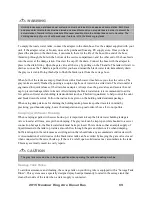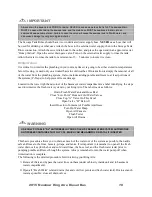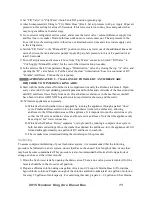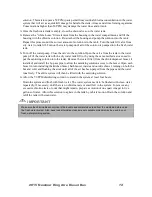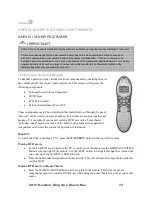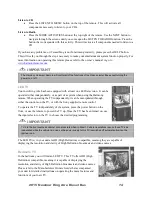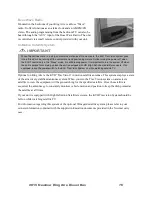
IMPORTANT
Inverters draw power from the “house” batteries to provide current to most of the appliances and accessories
in your unit without having to plug into shore power or run your generator. Because they use DC power from
the batteries to do that, energy consumption from those batteries is high, and increases significantly as more
appliances are added to the load. To extend battery life, minimize the number of appliances operating at any
given time. All AC operated appliances have a label attached to tell how much power they consume. Be sure
allow sufficient time for recovery / recharging between battery use cycles.
IMPORTANT
High battery voltage may be caused by excessive voltage from the alternator, solar panels, or another
external charge source. Be sure to correct the cause of the overcharging condition to prevent damage to the
batteries and electronic equipment in your King Aire. The inverter must be manually restarted after this fault.
12 VOLT DC SYSTEM
General Information
There are two separate 12 volt DC electrical systems on your King Aire; one for the “chassis” portion,
and the other for the “house” portion.
The “chassis” electrical system uses DC voltage to operate chassis related electrical accessories and
lights, such as the headlamps, dash instrumentation, engine starting and management circuitry, and so on.
This system includes a set of chassis batteries, and is charged in transit by the alternator. The chassis
batteries have a disconnect switch located in the rear engine compartment.
The “house” electrical system uses DC voltage to operate all the house related DC lights and accessories,
such as the interior lighting, ceiling vents and fans, slide outs, the water pump, and so on. The house
electrical system also supplies the power (through the house batteries) for the inverter to operate. When
110 AC current is present, the inverter has a charge circuit that engages to charge the house batteries.
Though separate in operation, the two DC electrical systems are tied together through a battery isolator
circuit. This circuitry is designed to keep the systems separated under most operating circumstances, but
still allows them to be tied together under certain conditions. This is accomplished through a component
called the Bi-Directional Isolator Relay Delay (BIRD). This component allows the two separate battery
systems to be tied together for charging purposes or for “boosting” purposes if one set of batteries is low.
In transit, the alternator on the engine is the power source for charging batteries. The function of the
“BIRD” allows the chassis batteries to be recharged off of the power coming from the alternator. Once the
chassis batteries have been recharged (approximately 13.3 VDC), the “BIRD” will turn on circuitry that
will then allow the house batteries to be charged in transit by the alternator. This allows both sets of
batteries to charge while the coach is in transit.
When the RV is parked (with the engine off), and is connected to 110 VAC power (either generator or
shore power), the “charge circuitry” in the inverter will engage, and will charge the house batteries. Once
the house batteries have reached full charge (approximately 13.3 VDC), the “BIRD” will again engage
circuitry that connects the two sets of batteries together, allowing the charge circuit in the inverter to
2015 Newmar King Aire Diesel Bus 61
Summary of Contents for King Aire 2015
Page 1: ......
Page 2: ......
Page 4: ......
Page 24: ...Spartan Lightbar Message Center 2015 Newmar King Aire Diesel Bus 22...
Page 25: ...System Initialization Sequence 2015 Newmar King Aire Diesel Bus 23...
Page 26: ...Telltale Warning Light Information 2015 Newmar King Aire Diesel Bus 24...
Page 46: ...2015 Newmar King Aire Diesel Bus 44...
Page 146: ...SilverLeaf Floor Heat screen 2 2014 Copyright Newmar Corporation All rights reserved p 61...
Page 162: ...SilverLeaf Advanced screen 2014 Copyright Newmar Corporation All rights reserved p 77...
Page 175: ...SilverLeaf Advanced screen 2014 Copyright Newmar Corporation All rights reserved p 90...























